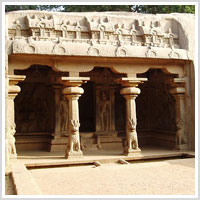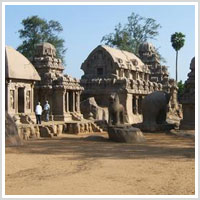RATE: By Car - Rs 399/- per person (Min 4)
Pick up & Drop from (Residence / Stay)
Bangalore -Mahabalipuram Tour Package

Shore Temple
The Shore Temple is so named because it over looks the Bay of Bengal. It is a structural temple, built with blocks of granite, dating from the 8th century AD. It was built on a promontory sticking out into the Bay of Bengal at Mamallapuram. The village was a busy port during the 7th and 8th century reign of the Pallava dynasty during the reign of Narasimhavarman II.
The temple is a combination of three shrines. The main shrine is dedicated to Shiva as is the smaller second shrine. A small third shrine, between the two, is dedicated to a reclining Vishnu and may have had water channeled into the temple, entering the Vishnu shrine. The two Shiva shrines are orthogonal in configuration. The two shikharas have a pyramidal outline, each individual tier is distinct with overhanging eaves that cast dark shadows.The temple has a garbhagriha in which the deity, Sivalinga, is enshrined, and a small mandapa surrounded by a heavy outer wall with little space between for circumambulation. The inner shrine dedicated to Ksatriyasimnesvara is reached through a passage while the other, dedicated to Vishnu, faces the outside. The Durga is seated on her lion vahana.

Arjuna penance
Measuring 96 feet (29 m) long by 43 feet (13 m) high, it is a giant open-air relief carved of the a monolithic rock. The monuments and sanctuaries were built by the Pallava kings in the 7th and 8th centuries. The legend depicted in the relief is the story of the descent of the sacred river Ganga to earth from the heavens led by Bhagiratha. The waters of Ganges are believed to possess supernatural powers. The descent of the Ganges and Arjuna’s Penance are portrayed in stone at the Pallava heritage site.
One of the notable, and perhaps ironic figures in the bas-relief is the figure of a cat standing on one leg. This may be related to the Panchatantra story of the cat who poses as an ascetic in order to lure a hare and a bird to come near. In one interpretation, a figure in the bas-relief who is standing on one leg is said to be Arjuna performing an austerity Tapas to receive a boon from Shiva as an aid in fighting the Mahabharata war.

Varaha Cave Temple
Varaha Cave Temple, an example of Indian rock-cut architecture dating from the late 7th century, is a rock-cut cave temple located at Mamallapuram, a tiny village south of Chennai in the state of Tamil Nadu, India. Part of the Group of Monuments at Mahabalipuram, the temple is a UNESCO World Heritage Site.
The temple is a small monolithic rock-cut temple with a mandapam dating from the 7th century. The Pallava doorkeepers in front of mandapa are two pillars and two semi-columns that have horned lions carved into the bases. On the rear wall of mandapa is the entrance in shrine with guardian figures on either side. Inside the mandapa the walls have four large sculptured panels, good examples of naturalistic Pallava art. Northern panel depicts Vishnu as Varaha, the boar, holding up Bhūmi, the earth goddess. Temple is entered through mandapa – beautiful verandah with two pillars and two semi-columns. All four contain doorkeepers – figures of horned lions at the bases of columns.

Five Rathas
This group of sanctuaries, founded by the Pallava kings, was carved out of rock along the Coromandel coast in the 7th and 8th centuries. It is known especially for its rathas (temples in the form of chariots), mandapas (cave sanctuaries), giant open-air reliefs such as the famous ‘Descent of the Ganges’, and the temple of Rivage, with thousands of sculptures to the glory of Shiva.
The nomenclature of the buildings is unfortunate. They are called rathas (pancha rathas means “five chariots”), and named individually after Draupadi and the Pandava brothers, although they have nothing to do with temple carts or the Mahabharata. It would be better to call them vimanas and just number them 1 through 5, but the popular names have stuck. Each temple is a monolith, carved whole from an outcropping of rock. (The number of separate formations is a matter of debate; the four north-south temples may have been carved from a single mass.)
